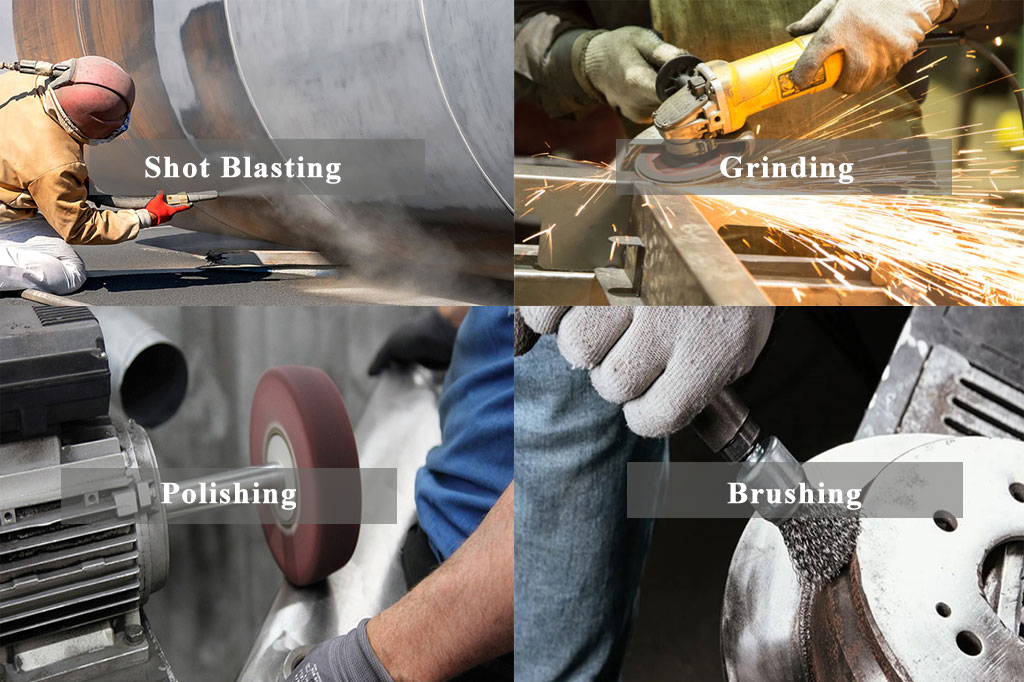Different mechanical finishing processes can be used to achieve various levels of smoothness, texture, or sheen depending on the metal part’s requirements.
Four commonly used mechanical surface finishing methods are shot blasting, grinding, polishing, and brushing.
In this article, we will explore each of these surface finishing methods and discuss which one is best suited for different types of metal parts.
A Quick Comparison Chart
| Feature | Shot Blasting | Grinding | Polishing | Brushing |
|---|---|---|---|---|
| Process Description | High-velocity particles (shots) are blasted at the metal surface to clean, strengthen, or finish. | Abrasive wheel removes material to create a smooth, precise finish. | Abrasive materials create a high-gloss, smooth surface using polishing compounds. | Rotating abrasive brushes create a uniform matte texture with linear patterns. |
| Surface Finish | Rough, uniform, sometimes textured. | Smooth, precise, can achieve fine finishes. | High gloss, mirror-like finish. | Matte finish with a linear, textured appearance. |
| Applications | Cleaning, rust removal, surface preparation, and strength enhancement. | Precision parts, smooth surfaces, and tight tolerances. | Aesthetic parts, mirror finishes, and corrosion resistance. | Durable and aesthetic parts, resistant to smudges, and used in appliances. |
| Advantages | Good for cleaning and preparing surfaces; strengthens the metal. | High precision, excellent for fine finishes and tight tolerances. | Achieves a shiny, high-quality finish; corrosion-resistant. | Provides a consistent and durable texture, easy to maintain. |
| Disadvantages | Rough finish, may not be suitable for delicate parts. | Material is removed, generating heat, may affect metal properties. | Time-consuming, may show scratches or wear over time. | Not as smooth as polishing, lower sheen than other methods. |
| Best for | Heavy-duty cleaning, rust removal, and preparation for coatings. | Parts requiring high precision and smoothness, such as gears and bearings. | Decorative items, parts requiring high aesthetics and corrosion resistance. | Industrial components, kitchenware, automotive parts, and furniture. |
| Durability | Increases durability by inducing compressive stress. | Durable, but surface may require additional coating for protection. | Generally less durable due to gloss finish susceptibility. | Durable and resistant to dirt and scratches. |
| Surface Texture | Rough, blasted surface. | Very smooth and precise surface. | Mirror-like, shiny, and smooth. | Matte with linear brush strokes. |
| Speed | Fast and efficient for large batches. | Moderate speed; dependent on part complexity. | Slow due to high attention to detail. | Faster than polishing, ideal for large quantities. |
Shot Blasting
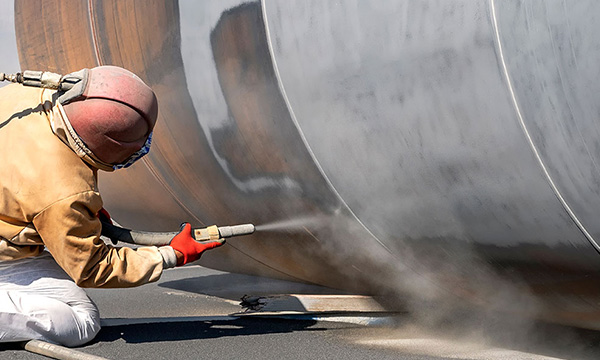
Shot blasting is a mechanical finishing process in which small, high-velocity particles (shots) are directed at the surface of a metal part. This process is used to clean, strengthen, or polish the metal surface, depending on the shot size and the intensity of the blast.
Pros of Shot Blasting:
- Surface Cleaning: Shot blasting is highly effective for removing rust, scale, dirt, and other contaminants, providing a clean and smooth metal surface.
- Surface Preparation: It’s often used to prepare a metal part for coating, welding, or painting.
- Uniform Finish: The process results in a uniform texture that can be consistent across large batches of parts.
- Strengthening: Shot blasting can improve the mechanical properties of the metal by inducing compressive stress on the surface.
Cons of Shot Blasting:
- Rough Surface: Shot blasting tends to leave a rougher finish compared to other methods, which might not be suitable for all applications.
- Not Suitable for Delicate Parts: The high-velocity impact can damage delicate components.
Best for:
- Heavy-duty cleaning, rust removal, and preparing parts for coatings or other treatments.
- Parts that don’t require a fine finish, such as structural components, machinery parts, and automotive frames.
Grinding
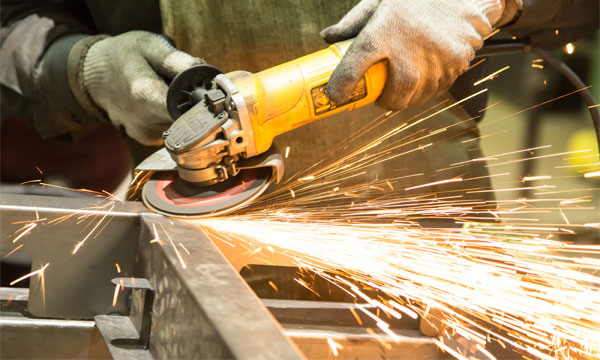
Grinding utilizes a rotating abrasive wheel to eliminate material from a metal part’s surface. This method is typically used for precision machining and for achieving very smooth or fine finishes on metals.
Pros of Grinding:
- Precision: Suitable for achieving tight tolerances and high-precision surface finishes.
- Smooth Finish: The process can achieve very smooth finishes, making it suitable for components where surface roughness must be minimized.
- Versatile: Grinding can be used on a wide variety of metals, including hardened and high-strength materials.
Cons of Grinding:
- Material Removal: While grinding can achieve a smooth finish, it also removes material, which can be a concern if only a slight finish change is required.
- Heat Generation: Grinding can generate significant heat, which could affect the material properties of the metal if not properly controlled.
Best for:
- Parts that require a precise and smooth finish, such as bearings, gears, and components used in high-performance machinery or automotive applications.
- Situations where accuracy and fine details are critical.
3. Polishing
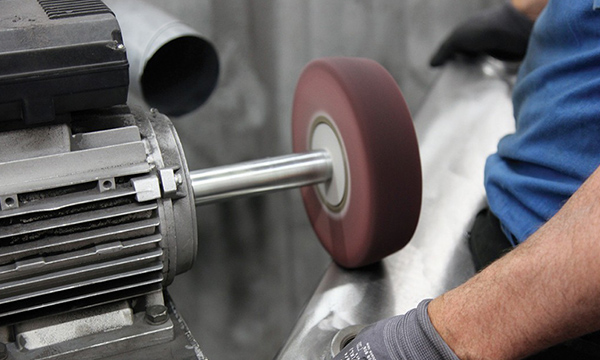
Polishing is a process that uses abrasive materials, often in conjunction with a polishing compound, to achieve a high-gloss, smooth finish. The process may involve hand or machine methods, such as buffing with a soft cloth or using a rotating abrasive wheel.
Pros of Polishing:
- High Gloss Finish: Polishing creates a smooth and shiny surface, ideal for aesthetic purposes or applications where light reflection is important.
- Corrosion Resistance: A polished surface typically includes a protective layer that improves corrosion resistance.
- Mirror-Like Finish: Produces a mirror-like finish, ideal for decorative applications.
Cons of Polishing:
- Time-Consuming: Polishing is generally more labor-intensive and time-consuming than other finishing methods.
- Surface Vulnerability: Although polished surfaces have an attractive appearance, they tend to be more prone to scratches and wear over time.
Best for:
- Decorative items, jewelry, or parts requiring high aesthetics, such as automotive trim, kitchen appliances, and architectural components.
- Applications requiring corrosion resistance and high cleanliness standards.
4. Brushing
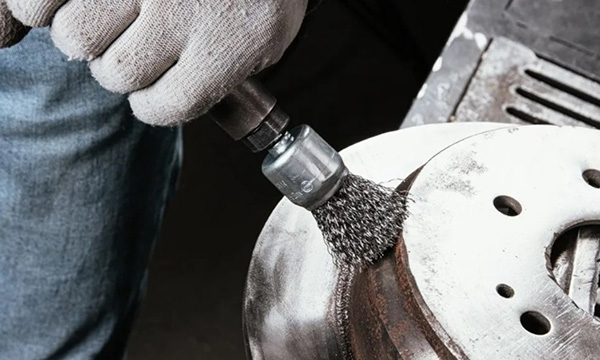
Brushing involves the use of a rotating abrasive brush to create a uniform surface texture on the metal. The process imparts a matte finish with visible linear patterns on the surface. Brushing is commonly used to remove surface imperfections and to create a consistent appearance on metal products.
Pros of Brushing:
- Unique Texture: Brushing imparts a distinctive, aesthetically pleasing texture that can hide fingerprints, smudges, or other blemishes.
- Durability: This finish is highly durable and wear-resistant, making it suitable for both industrial and consumer products.
- Easy to Maintain: The matte finish is less likely to show dirt and scratches compared to a glossy surface.
Cons of Brushing:
- Not as Smooth: While it provides a textured finish, it doesn’t offer the smoothness or shine of polishing.
- Limited Gloss: Brushed finishes tend to have a lower sheen than polished surfaces, which might not be suitable for all applications.
Best for:
- Industrial components, appliances, and architectural materials where durability and aesthetics matter but a high-gloss finish is not required.
- Products such as kitchenware, automotive parts, and furniture with a practical yet stylish finish.
Which Mechanical Surface Finish Is Best for Your Metal Parts?
- Functionality vs. Aesthetics: If the metal part will be used in an application where the appearance is crucial (e.g., decorative metal items, automotive trims), then polishing or brushing may be the best choice. On the other hand, for functional parts requiring strength and durability, shot blasting or grinding may be more suitable.
- Durability Needs: Shot blasting and brushing create finishes that are less prone to showing scratches or dirt, making them ideal for parts exposed to harsh environments. Although polishing enhances aesthetics, maintaining the finish may require additional care.
- Material Type and Application: The type of metal you’re working with and the specific application of the part will influence the best choice. Grinding and polishing are widely used for precision components such as bearings, gears, and medical devices. Shot blasting and brushing are often better for industrial or structural parts where functionality is the priority.

